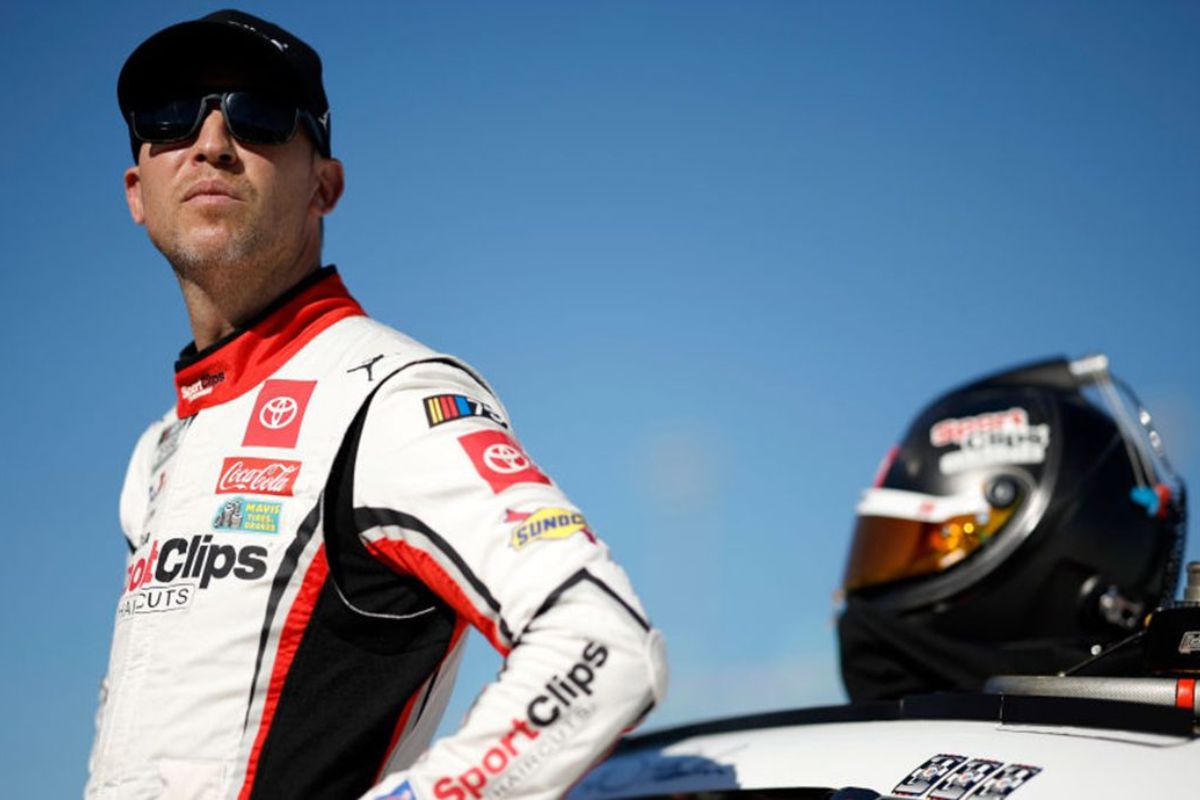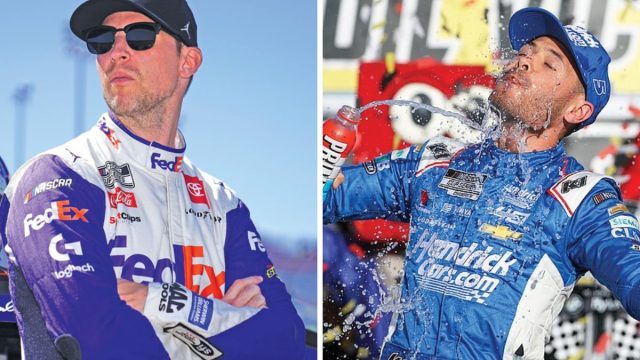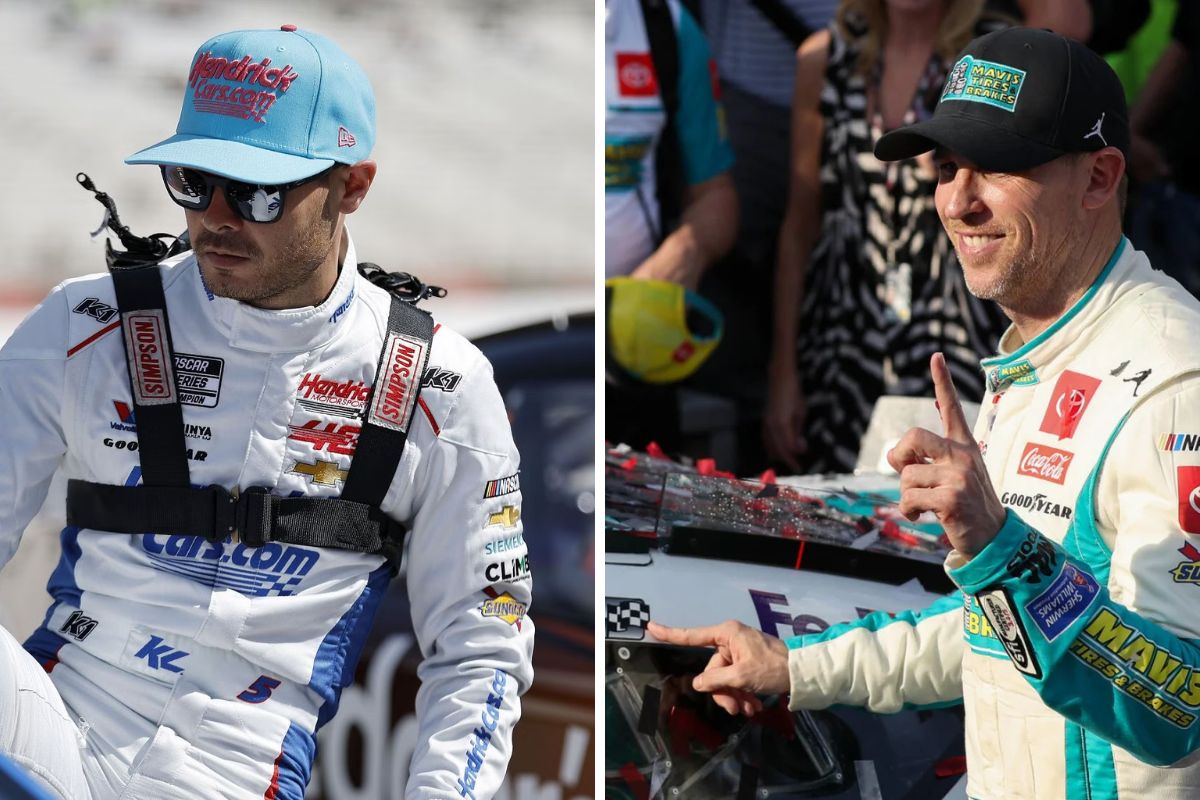Denny Hamlin Approves Kyle Larson’s Win: In NASCAR racing, the validation of Kyle Larson‘s controversial win by Denny Hamlin provides a fascinating case study into the precision required in sport adjudication. Hamlin’s focus on the minutiae of race finish evidence—specifically the analysis of finish line photos and car splitters—underscores the critical need for accuracy in determining outcomes. His endorsement also sparks a broader conversation on the potential technological advancements necessary to guarantee undisputed race results.
Key Takeaways
- Denny Hamlin confirms Kyle Larson’s win, despite controversy over race finish accuracy.
- Hamlin highlights the importance of technology in verifying close race outcomes.
- He discusses the role of camera angle and speed in creating optical illusions at finishes.
- Hamlin urges NASCAR to upgrade camera technology for clearer and more precise adjudication.
- Despite the uncertain verdict, Hamlin encourages public trust in the race’s official results.
Controversy Surrounding Kyle Larson’s Win
The controversy surrounding Kyle Larson’s win at Kansas Speedway frequently centers on an alleged optical illusion during the race’s climactic finish, casting doubt on the legitimacy of the results as perceived by both spectators and competitors alike. This phenomenon, while not uncommon in high-speed sports, highlights the intricacies involved in the accurate determination of race outcomes, where mere milliseconds can dictate the standings.
At the heart of this dispute lies the complex interaction between human visual perception and the mechanical precision of technology used in determining finishes. In races like these, the speed of the vehicles combined with the angle of observation can greatly affect how positions are perceived.
Further complicating the issue are factors such as the positioning of cameras and the frame rate at which they capture the race. These technical aspects can create differences between the real-time observations of onlookers and the official results based on video review. The reliance on technology to determine race outcomes speaks to the sport’s commitment to precision, yet it also introduces a layer of abstraction that can feel unsatisfactory to those relying on the immediacy of human sight.

Hamlin’s Analysis of the Finish
In his insightful podcast ‘Actions Detrimental,’ Denny Hamlin, despite Hamlin’s P5 finish in the race, explores the intricate details of Kyle Larson’s controversial win, focusing on the crucial moment captured in the official race finish photograph. Hamlin carefully dissects the visual evidence, utilizing his seasoned expertise to offer a clear, objective analysis of the moment Larson crossed the finish line.
“if you look at that, does it look like the five’s front splitter is hanging out like a tongue? Sure, but I think that you can better see that there’s a little sliver of daylight between the 17 splitter and that line.” – hamlin
Hamlin highlights the positioning of Larson’s splitters, a crucial element in determining the precise finish time and relative position in the race. While initially, these splitters seemed to provide Larson with a slight advantage, Hamlin clarifies this observation by stressing the consistency of these components across all Cup Series cars. He explains that the visual difference can be deceptive without understanding the standard specifications and installation angles of these splitters.
- The sharp, frozen motion of Larson’s car as it speeds past the finish line, wheels barely touching the tarmac.
- The intense sunlight reflecting off the gleaming, maintained surface of Larson’s vehicle, accentuating the contentious splitters.
- The blurred background, spectators captured in mid-cheer, creating a contrast between the stillness of technical scrutiny and the frenzied joy of the moment.
Hamlin’s Theory
Building on his meticulous analysis, Denny Hamlin introduces a compelling theory that challenges the initial perception of Kyle Larson’s victory. Hamlin’s theory centers around a significant moment captured in the race, where he identifies an optical illusion that many might have missed. According to Hamlin, there was a sliver of daylight between the splitters of Larson’s #5 car and the #17 car, which is essential in understanding the outcome. This, Hamlin argues, indicates that Larson’s car did indeed cross the critical black line, albeit barely—raising questions about the clarity of the win.
“What I see here is the five’s nose, the actual tip of the nose, is crossing the black line. Again, he’s not wrong. It’s a little blurry, but it’s, it crosses that line and,” Hamlin adding, “I see a little gap with the 17.”
The detailed examination by Hamlin is not just a mere assertion but is backed by photographic evidence that he scrutinized.
| Element | Description | Impact on Perception |
|---|---|---|
| Daylight between cars | Slight visible gap between the #5 and #17 cars | Suggests closer competition |
| Position of #5 car | Tip of Larson’s car crosses the black line | Implies potential lead |
| Optical illusion | Misinterpretation of visual information | Questions initial judgment |
| Hamlin’s expertise | Experienced racer’s analytical approach | Lends credibility to theory |
| Photographic evidence | Visual proof supporting the claim | Strengthens the argument |

The Benefit to NASCAR
Controversies like the disputed finish at Kansas Speedway often serve as catalysts, invigorating NASCAR’s fan engagement and media coverage. The spectacle of uncertainty and drama not only holds the current fanbase’s attention but also attracts new viewers who are drawn to the unfolding narratives.
“I love that we’re talking about this because it’s a great finish. It’s good for the sport. It’s good for everyone. It sucked for Chris Buescher. It sucked for me. Another race inside 10 laps to go I’m leading.” hamlin said.
When a race concludes with an element of controversy, it naturally garners more post-race analysis and discussion. This extends beyond the immediate race day, feeding into sports news cycles and social media debates. Such incidents serve to keep NASCAR prominently in the public eye, ensuring a continuous engagement with both dedicated fans and the general sports audience.
- Increased Media Coverage: Major sports outlets and casual observers both are drawn to cover the dispute, leading to broader coverage and more diverse viewpoints being shared.
- Social Media Buzz: Platforms like Twitter and Facebook light up with opinions, memes, and replays, keeping the conversation going and increasing interaction among fans.
- Civic Engagement: Local and national discussions about race rules and sportsmanship can lead to a deeper public understanding of NASCAR’s complexities.
Call for Camera Equipment Upgrade
Denny Hamlin’s suggestion for an improvement in NASCAR’s camera technology highlights an important need for accuracy in capturing race finishes. In a sport where milliseconds can determine the outcome, the precision of finish-line technology is not just beneficial, but vital. Hamlin’s call to upgrade camera equipment comes after a race marked by a spectacular, yet uncertain finish.
“I agree. Maybe we should upgrade the camera slightly. I mean, upgrade what, like, what do you want? And like, I think it’s, I think you could have said too close to call.” -hamlin
Hamlin’s perspective is not merely about improving visual clarity but speaks to the integrity of racing outcomes. If NASCAR were to adopt higher-definition and higher-speed cameras, it could provide indisputable evidence in tight races. This change would not only satisfy competitors and teams but also enrich fan experience and trust in the sport’s adjudication system.
News in Brief: Denny Hamlin Approves Kyle Larson’s Win
Denny Hamlin’s endorsement of Kyle Larson’s victory in the face of an ambiguous decision highlights the complexities involved in NASCAR race adjudications.
By scrutinizing official race finish visuals and the minute details of Larson’s car, Hamlin not only enriches the discourse on race outcomes but also emphasizes the need for technological improvements in monitoring equipment.
This advocacy for precision marks a significant moment for NASCAR, urging a reassessment of current methodologies to guarantee fairness and accuracy in the sport’s competitive assessments.
Our Reader’s Queries
Q: Are Denny Hamlin and Kyle Larson friends?
A: Hamlin and Larson maintain a friendship off the track, unaffected by any on-track rivalries. Despite their battles on the circuit, their camaraderie remains steadfast, demonstrating mutual respect and sportsmanship.
Q: Who owns Kyle Larson’s Sprint car?
A: Kyle Larson Racing, formerly Larson Marks Racing, epitomizes American sprint car and midget car racing. Owned by NASCAR driver Kyle Larson, the team embodies his passion for motorsports beyond the asphalt, showcasing his dedication to diverse racing disciplines.
Q: Has Denny Hamlin ever won a road race?
A: In a remarkable feat, Hamlin clinched his inaugural road course victory, leading a mere 10 laps of the 90-lap race, yet seizing the pivotal moments. This triumph offered redemption after a near-win at Sonoma Raceway, where a final-lap mishap cost him victory against Tony Stewart.
Also Read: Denny Hamlin Questions Chris Buescher Amid Kyle Larson’s Win

